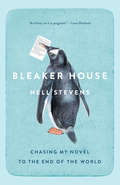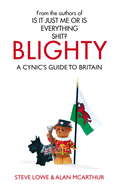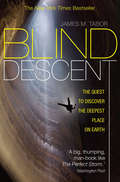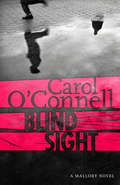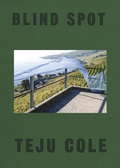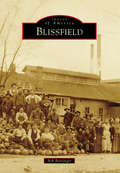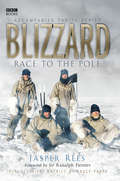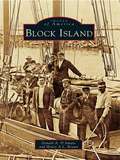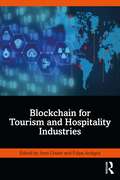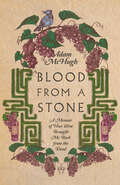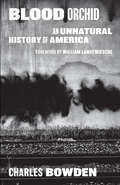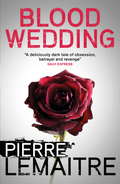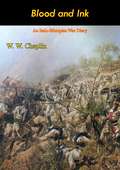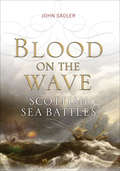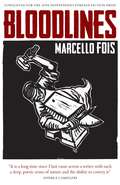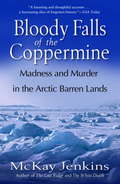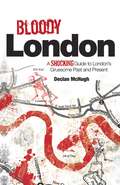- Table View
- List View
Bleaker House: Chasing My Novel to the End of the World
by Nell StevensA girl, a laptop, and a waddle of penguins. In this witty and genre-defying memoir, a young writer can travel anywhere she wants to finally finish her novel—and ends up on a frozen island at the bottom of the world. Twenty-seven-year-old Nell Stevens was determined to write a novel, but life kept getting in the way. Then came a game-changing opportunity: she won a fellowship that would let her live, all expenses paid, anywhere in the world to research and write a book. Would she choose a glittering metropolis, a romantic village, an exotic paradise? Not exactly. Nell picked Bleaker Island, a snowy, windswept pile of rock in the Falklands. There, in a guesthouse where she would be the only guest, she could finally rid herself of distractions and write. Before the spring thaw, surely she’d have a novel. And indeed, other than sheep, penguins, paranoia, and the weather, there aren’t many distractions on Bleaker. Nell gets to work on a charming Dickensian fiction she calls Bleaker House—only to discover that total isolation and 1,085 calories a day are far from ideal conditions for literary production. With deft humor, the memoir traces Nell’s island days and slowly reveals details of the life and people she has left behind in pursuit of her writing. They pop up in her novel, too, and in other fictional pieces that dot the book. It seems that there is nowhere Nell can run—an island or the pages of her notebook—to escape the big questions of love, art and ambition. Terrifically smart, full of wry writing advice, and with a clever puzzle of a structure, Bleaker House marks the arrival of a fresh new voice in creative nonfiction.
Bleckley County
by William Lonnie BarlowIn 1868, Dykesboro was incorporated as Cochran. The Macon and Brunswick Railroad enabled the community to ship cotton and corn and receive needed goods. As the town began to grow, education was always promoted by the churches. Ebenezer Academy, founded in 1884, became Middle Georgia College. In 1912, Bleckley County was created, and the county courthouse began operation on January 1, 1914. The local economy was good, and World War I brought a period of prosperity due to the need for food and fiber. In the 1920s, the boll weevil devastated the agricultural cotton economy and the Great Depression brought loss of economic wealth and financial hardships that were not relieved until after World War II.
Blighty: The Quest for Britishness, Britain, Britons, Britishness and The British
by Steve Lowe Alan McArthurBritain. What's that all about then?Having skewered modern life and culture in the bestselling Is it Just Me or is Everything Shit?, Steve Lowe and Alan McArthur set out to uncover the deep dark truth about Britain - its history, its myths and its people. Over the course of a year they endure the Last Night of the Proms and search for a couple of pissed dragons under a hill in Wales. They witness Scotland rising again (a bit), encounter terrifying Europhobe ladies in Surrey and lose the will to live in Gibraltar. They also meet a lot of druids. Hilarious, provocative and filled with fascinating facts, Blighty offers a brilliant, alternative vision of Britain - the island in the Atlantic that some people call Britain.
Blind Courage
by Bill Irwin Dave MccaslinBill Irwin, a confessed non hiker, and his German Shepherd Seeing eye dog Orient, through hike the 2000 mile plus Appalachian Trail. With the help of Orient, god, and many great friends he meets along the way, Bill tells of the trials, triumphs and adventures on the trail. From the time a bear slowed their progress, to the time he almost slid off a cliff to certain death. The book is filled with stories that will make you laugh, reflect, and maybe bring you to tears.
Blind Descent: The Quest to Discover the Deepest Place on Earth
by James M. TaborThe deepest cave on earth was a prize that had remained unclaimed for centuries, long after every other ultimate discovery had been made: both poles by 1912, Everest in 1958, the Challenger Deep in 1961. In 1969 we even walked on the moon. And yet as late as 2000, the earth's deepest cave---the supercave---remained undiscovered. This is the story of the men and women who risked everything to find it, earning their place in history beside the likes of Peary, Amundsen, Hillary, and Armstrong. In 2004, two great scientist-explorers are attempting to find the bottom of the world. Bold, heroic American Bill Stone is committed to the vast Cheve Cave, located in southern Mexico and deadly even by supercave standards. On the other side of the globe, legendary Ukrainian explorer Alexander Klimchouk---Stone's polar opposite in temperament and style, but every bit his equal in scientific expertise, physical bravery, and sheer determination---has targeted Krubera, a freezing nightmare of a supercave in the Republic of Georgia, where underground dangers are compounded by the horrors of separatist war in this former Soviet republic. Blind Descent explores both the brightest and darkest aspects of the timeless human urge to discover, to be first. It is also a thrilling epic about a pursuit that makes even extreme mountaineering and ocean exploration pale by comparison. These supercavers spent months in multiple camps almost two vertical miles deep and many more miles from their caves' exits. They had to contend with thousand-foot drops, deadly flooded tunnels, raging whitewater rivers, monstrous waterfalls, mile-long belly crawls, and much more. Perhaps even worse were the psychological horrors produced by weeks plunged into absolute, perpetual darkness, beyond all hope of rescue, including a particularly insidious derangement called The Rapture. James M. Tabor was granted unprecedented access to logs, journals, photographs, and video footage of these expeditions, as well as many hours of personal interviews with surviving participants. Blind Descent is an unforgettable addition to the classic literature of discovery and adventure. It is also a testament to human survival and endurance-and to two extraordinary men whose relentless pursuit of greatness led them to heights of triumph and depths of tragedy neither could have imagined.
Blind Descent: The Quest to Discover the Deepest Place on Earth
by James M. TaborThe deepest cave on earth was a prize that had remained unclaimed for centuries, long after every other ultimate discovery had been made. This is the story of the men and women who risked everything to find it, earning their place in history beside the likes of Peary, Amundsen, Hillary, and Armstrong.In 2004, two great scientist-explorers attempted to find the bottom of the world. Bold, American Bill Stone was committed to the vast Cheve Cave, located in southern Mexico and deadly even by supercave standards. On the other side of the globe, legendary Ukrainian explorer Alexander Klimchouk - Stone's opposite in temperament and style - had targeted Krubera, a freezing nightmare of a supercave in the Republic of Georgia.Blind Descent explores both the brightest and darkest aspects of the timeless human urge to discover - to be first. It is also a thrilling epic about a pursuit that makes even extreme mountaineering and ocean exploration pale by comparison. These supercavers spent months in multiple camps almost two vertical miles deep and many more miles from their caves' exits. They had to contend with thousand-foot drops, deadly flooded tunnels, raging whitewater rivers, monstrous waterfalls, mile-long belly crawls, and much more. Perhaps even worse were the psychological horrors produced by weeks plunged into absolute, perpetual darkness, beyond all hope of rescue, including a particularly insidious derangement called 'The Rapture'.Blind Descent is a testament to human survival and endurance - and to two extraordinary men whose relentless pursuit of greatness led them to heights of triumph and depths of tragedy neither could have imagined.
Blind Sight: Kathy Mallory 12
by Carol O'ConnellMallory Book 12: Blind Sight is the twelfth NYPD detective Kathy Mallory novel from New York Times bestseller Carol O'Connell, master of knife-edge suspense and intricate plotting. Fans of Karin Slaughter and Stieg Larsson will be thrilled by New York's darkest cop. 'Carol O'Connell is a consummate storyteller - a unique talent who deserves to be a household name' - Val McDermid Detective Kathy Mallory. New York's darkest. You only underestimate her once.The nun is dead. Her body lies on the mayor's lawn with three others, all killed at different times, in different places, and dumped there. There should be five - but the boy is missing.One second he was there...Jonah Quill, blind since birth, sits in a car driven by a killer and wonders where they are going. Though blind, Jonah sees more than most people do. He's counting on this secret to save his life.Then gone.Detective Kathy Mallory is counting on herself to save his life. It takes her a while to realise that the missing-person case she is pursuing is so intimately connected to the massacre on the mayor's lawn. But she will find Jonah - she just hopes it will be in time.
Blind Spot
by Siri Hustvedt Teju ColeIn this innovative synthesis of words and images, the award-winning author of Open City and photography critic for The New York Times Magazine combines two of his great passions.One of Time’s Best Non-Fiction Books of 2017 So Far “To look is to see only a fraction of what one is looking at. Even in the most vigilant eye, there is a blind spot. What is missing?” When it comes to Teju Cole, the unexpected is not unfamiliar: He’s an acclaimed novelist, an influential essayist, and an internationally exhibited photographer. In Blind Spot, readers follow Cole’s inimitable artistic vision into the visual realm as he continues to refine the voice, eye, and intellectual obsessions that earned him such acclaim for Open City. Here, journey through more than 150 of Cole’s full-color, original photos, each accompanied by his lyrical and evocative prose, forming a multimedia diary of years of near-constant travel: from a park in Berlin to a mountain range in Switzerland, a church exterior in Lagos to a parking lot in Brooklyn; landscapes, beautiful or quotidian, that inspire Cole’s memories, fantasies, and introspections. Ships in Capri remind him of the work of writers from Homer to Edna O’Brien; a hotel room in Wannsee brings back a disturbing dream about a friend’s death; a home in Tivoli evokes a transformative period of semi-blindness, after which “the photography changed. . . . The looking changed.” As exquisitely wrought as the work of Anne Carson or Chris Marker, Blind Spot is a testament to the art of seeing by one of the most powerful and original voices in contemporary literature.Praise for Blind Spot“This lyrical essay in photographs paired with texts explores the mysteries of the ordinary. Cole’s questioning, tentative habit of mind, suspending judgement while hoping for the brief miracle of insight, is a form of what used to be called humanism.”—New York Times Books Review (Editors’ Choice)“An eye-opening exploration of the world, time, and how the two connect.”—Nylon“[Teju] Cole’s fiction and essays are incredible, unexpected, and beautiful; he’s also a spectacular photographer. His first collection of photographs, each image accompanied by his stunning prose, promises to show us the world through his eyes, which always seem to see things in a brilliant new light.”—Lisa Lucas, National Book Foundation“Once you get a taste of [Cole’s] writing, you can quickly (and hungrily) burn through what’s available. Thankfully, Blind Spot will indulge the senses by combining both of Cole’s loves in this . . . full-color collection of Cole’s photos, accompanied by his prose.”—The Week“Many artists have felt the lure of juxtaposing photographs and text, but few have succeeded as well as Teju Cole. He approaches this problem with an understanding of the limitations and glories of each medium.”—Stephen Shore, author of Uncommon Places“Cole’s deeply affecting work juxtaposes tragedy with hidden-in-plain-sight beauty as he embraces ‘poetic possibility’ in every scene and moment.”—Booklist “Memoir meets museum catalog . . . A strange, cerebral, and very beautiful journey.”—Kirkus Reviews“This ambitious study deserves a spot on the shelf next to Roland Barthes’s Camera Lucida and Susan Sontag’s On Photography.”—Publishers Weekly (starred review)
Blissfield (Images of America)
by Bob BarringerIn 1824, Hervey Bliss, who according to Duane DeLoach's Blissfield's First 150 Years stood "about five feet, three inches tall, with a somewhat florid complexion and . . . blue eyes," left Monroe County, blazed a trail 20 miles through the woods, built a log cabin, and founded the village of Blissfield on the west bank of the River Raisin. In 1826, George Giles, a neighbor of Bliss in Monroe County, moved onto land on the east side of the river in a place he called Lyons. Before the river was bridged, Blissfield consisted of two separate communities, each with its own schools and downtown areas; the village retains some of that split personality. Triple bridges, once nationally famous, remain the proud symbol of Blissfield, joining what the River Raisin keeps separate and what, as floodwaters insist, the river can still force apart.
Blizzard - Race to the Pole
by Jasper ReesIn late 1911, the final year of the Edwardian age, a British naval captain and a Norwegian conqueror of the North-West Passage embarked on the most gruelling race ever run. Their aim was not only to lead the first expedition to the South Pole, but also to live to tell the tale. Six months later, Robert Falcon Scott and four of his party were dead, while Roald Amundsens victory had been wired around the world. A century on, the debate still rages. Was Scott unfortunate or incompetent? Was Amundsen a genius or lucky? In a unique television experiment, two teams led by the Norwegian explorer Rune Gjeldnes and the television anthropologist Bruce Parry, star of the BBC2 series Tribe, set out to recreate the famous race. Wearing the same type of clothing as their predecessors, surviving on the same diet, using the same equipment and travelling over the same distance, they seek to answer some of the burning questions. Blizzard is a dramatic chronicle of both the original epic, and its reconstruction. Jasper Reess narrative skilfully intertwines past and present as he brings to life an extraordinary cast of characters. They may be separated from their predecessors by nearly a hundred years, but the modern race teams soon discover that, in polar travel, nothing changes. Among the hardships they face are uncontrollable dogs, inedible food, invisible crevasses, unimaginable cold, all in an unending prairie of snow. Incorporating the gripping diaries of Parry and Gjeldnes, Blizzard paints an astonishing picture of comradeship in the face of physical danger and psychological torment in the most life-threatening habitat on earth.
Block Island (Images of America)
by Donald A. D’amato Henry A.L. BrownBlock Island explores the evolution of the small, 7-by-3-mile island that lies between Point Judith, Rhode Island, and Montauk Point, New York. In 1637, Block Island, also known as "New Shoreham," was claimed by Massachusetts soldiers who took the land away from the Manisses Indians. When the island was sold to 16 proprietors in 1660, the history of Block Island as part of Rhode Island began. At any time of the year, Block Island has a special look and charm of its own. In addition to its beautiful sandy beaches and thundering surf, the island is plentiful with rolling hills, fertile valleys, and ponds. Within these pages, meet the early residents of the island and learn how this farming and fishing community first developed as a summer resort destination in the late 1800s. Summer scenes from the late nineteenth and early twentieth centuries, including views of the steamers that arrived daily carrying thousands of passengers from New York, Connecticut, and other parts of Rhode Island, are also featured in this collection.
Blockchain for Hospitality and Tourism: A Guide to the Future
by Dominika DuziakLearn blockchain in a simple, non-tech way and explore the different emerging technologies that open a world of opportunities in the space of tourism and hospitality. This book showcases examples of blockchain-based solutions implemented in different industries and connects them to use cases in hospitality and tourism (disintermediation, payments, loyalty programs, supply chain management, identity management etc.). Blockchain is one of the disruptive technologies that lays foundations for Web3.0, NFTs, Metaverse and other innovations. Despite many benefits, its adoption in the hospitality industry is very slow. Lack of awareness and connection to clear return-on-investment, coupled with many misconceptions and general perception of complexity is one of the main reasons why hospitality managers are reluctant to embark on the blockchain train.Blockchain for Hospitality and Tourism serves as a practical guide to the world of innovations, from the basics of blockchain to “how to start a project” with brief explanations of different technologies and capabilities. You'll review NFTs and Metaverse, along with current developments, tools, and platforms. After reading this book, you'll be equipped with enough knowledge to make strategic business decisions and able to discuss these topics within your organization and with vendors and suppliers in a comfortable way. As blockchain enters the next phase of its evolution, with more user-friendly interfaces and interoperability, see how it opens a world of opportunities in the space of tourism and hospitality. What You'll LearnBlockchain-based innovations – cryptocurrencies and digital asset management, NFTs, Web3.0, Metaverse)Review applications of blockchain in selected industries Start a blockchain project Who This Book is ForHospitality professionals, including hotel managers and general managers, revenue management directors, operations directors, hotel IT managers, asset managers, brand strategy managers, marketing managers. Hospitality students will benefit as well. ·
Blockchain for Tourism and Hospitality Industries
by Irem Onder Fulya AcikgozThis insightful book is the first to explain the basics of blockchain and its applications in the service industry, as well as potential future implementations of the technology. Embellished with explanatory diagrams throughout, this book predominantly focuses on blockchain as a prominent driver of digital transformation within the service sector and explores its potential applications within the tourism and hospitality industries. Expert-led and logically structured, the chapters explore a plethora of concepts within the service industry and explain the possibilities of blockchain technology and its pros and cons. Key topics include blockchain and its current and potential future impact on food and agricultural supply chains, the sharing economy, non-fungible tokens (NFTs), financial systems and payments, medical tourism, sustainability, and smart contracts. The book seeks to inspire and influence industry figures to plan ahead and develop business strategies using blockchain. International in scope, this engaging volume will be of pivotal interest to industry experts as well as researchers and tourism, hospitality, and technology students interested in learning more about blockchain and its potential for the service industry.
Blood From a Stone: A Memoir of How Wine Brought Me Back from the Dead
by Adam S. McHugh"This is the story of how wine brought me back from the dead."Thus begins Adam McHugh's transition through the ending of one career—as a hospice chaplain and grief counselor—into the discovery of a new life in wine among the grapevines of the Santa Ynez Valley of California."This is the corkscrewing tale of how I got to Santa Ynez, eventually, and the questions that came up along the way," he continues. "You and I are going to take a long wine tour together on our way there, and we will make plenty of stops for a glass and some local wine history. As you will see, I reached into the old, old story of wine in order to find my new story, which begins, as so many wine love stories do, in the French countryside. Most stories about religion and drink are stories of recovery. I'm not sure if mine isn't a story about recovery too."Adam's story is one of being forced to reevaluate and remake his life when things fell apart. But more than that, it's a story about finding healing through the good gifts of wine, friends, and the beauty of wine country. Pour a glass and join the adventure from the south of France to Champagne to the California Central Coast.
Blood Orchid: An Unnatural History of America
by Charles BowdenThe renowned author explores the violent and corrupt history of America in “a haunted, often brilliant journey into the heart of our darkness” (Frederick Turner).Blood Orchid is the first volume in Charles Bowden’s Unnatural History of America sextet. It is a deeply personal and bracingly sharp chronicle of his quest to unearth our ugly truths. Through stark observations and visceral experiences, Bowden presents a dizzying excavation of the systemic violence and corruption at the roots of American society. Bowden visits dying friends in skid row apartments in Los Angeles, traverses San Francisco byways lined with clubs and joints, and roams through village bars and streets in the Sierra Madre mountains. In these wanderings resides a yearning for the understanding of past and present sins, the human penchant for warfare, abuse, and oppression, and the true war between humanity, the industrialized world, and the immense tolls of our shared land.
Blood Orchid: An Unnatural History of America
by Charles BowdenThe renowned author explores the violent and corrupt history of America in “a haunted, often brilliant journey into the heart of our darkness” (Frederick Turner).Blood Orchid is the first volume in Charles Bowden’s Unnatural History of America sextet. It is a deeply personal and bracingly sharp chronicle of his quest to unearth our ugly truths. Through stark observations and visceral experiences, Bowden presents a dizzying excavation of the systemic violence and corruption at the roots of American society. Bowden visits dying friends in skid row apartments in Los Angeles, traverses San Francisco byways lined with clubs and joints, and roams through village bars and streets in the Sierra Madre mountains. In these wanderings resides a yearning for the understanding of past and present sins, the human penchant for warfare, abuse, and oppression, and the true war between humanity, the industrialized world, and the immense tolls of our shared land.
Blood Wedding
by Pierre LemaitreSophie is haunted by the things she can't remember - and visions from the past she will never forget.One morning, she wakes to find that the little boy in her care is dead. She has no memory of what happened. And whatever the truth, her side of the story is no match for the evidence piled against her. Her only hiding place is in a new identity. A new life, with a man she has met online. But Sophie is not the only one keeping secrets . . .For fans of Gone Girl and Lemaitre's own internationally bestselling Alex, Blood Wedding is a compelling psychological thriller with a formidable female protagonist.Translated from the French by Frank Wynne
Blood Wedding
by Pierre LemaitreSophie is haunted by the things she can't remember - and visions from the past she will never forget.One morning, she wakes to find that the little boy in her care is dead. She has no memory of what happened. And whatever the truth, her side of the story is no match for the evidence piled against her. Her only hiding place is in a new identity. A new life, with a man she has met online. But Sophie is not the only one keeping secrets . . .For fans of Gone Girl and Lemaitre's own internationally bestselling Alex, Blood Wedding is a compelling psychological thriller with a formidable female protagonist.Translated from the French by Frank Wynne
Blood Wedding
by Pierre LemaitreSophie Duguet is losing her grip. Haunted by visions from her past, of her loving husband, who committed suicide after a car accident. One morning she wakes to find Leo, the child in her care, strangled in his bed by Sophie's own shoelaces. She can remember nothing of the night before. Could she really have killed him? She flees in panic, but this only cements her guilt in the eyes of the law.Not long afterwards it happens again - she wakes with blood on her hands, with no memory of the murder committed. Just what is it that comes over Sophie when she sleeps? And what else might she be capable of? Wanted by the police, and desperate to change her identity, Sophie decides to find a man to marry. To have and to hold. For better or for worse. Till death does them part . . .
Blood and Ink: An Italo-Ethiopian War Diary
by Floyd Gibbons W. W. ChaplinIn the history books, the Italo-Ethiopian War will doubtless be entered as one of the strangest wars ever waged. History will record the spectacle of a primitive people—haphazardly armed and lacking in modern military technique—seeking to resist Mussolini’s modern war machine by tribal cunning on the battlefield and up-to-date intrigue in the diplomatic councils of Europe.But what the history books will not record, W.W. (“Bill”) Chaplin tells in this fascinating volume. It is behind the scenes of politics and bloodshed in this curious conflict that Mr. Chaplin takes the reader in a vivid diary of his day-by-day experiences and observations at the Italo-Ethiopian War front.Written with the dramatic simplicity of a newspaperman trained in the art of brevity, Mr. Chaplin’s account of the thousand and one quixotic incidents in a war correspondent’s life in Ethiopia sparkles with interest and amusement. From the beginning when he describes his departure on an Italian troop-ship at Naples to the very end when he returns to the same port as the approaching rainy season slows down the pace of the war, Mr. Chaplin records an odyssey as strange as the war itself.The reader is led through picturesque by-ways into the heart of the Ethiopian war zone and shown not only what war has wrought on the battlefield but what it has wrought in the hearts of fighting men. This and much more that is of human texture, Mr. Chaplin tells in a diary that reflects undiluted curiosity and a subtle sense of the dramatic.
Blood on the Wave: Scottish Sea Battles
by John SadlerA history of combat in Scottish waters—from the Iron Age to the Cold War—and the changes in the technology and tactics of naval warfare. Scotland&’s long coastline runs from the waters of Galloway and the Solway, through the Irish Sea to the long sea lochs and myriad islands of the Celtic west, around grim Cape Wrath, the coast of Caithness, Pentland Firth and the Orkneys, eastward down to the Moray Firth, the eastern seaboard, to the Forth and the sentinel of the Bass Rock. It is an ancient strand redolent with history. Sea battles have been fought in its lee from the time of Agricola to the Atlantic convoys. In Blood on the Wave, John Sadler embarks on a pilgrimage around Scotland&’s rugged and stunning coastline, to explore the fascinating history that has occurred in its waters. Beautifully illustrated throughout with photographs and line drawings, the narrative also describes developments in ship building technique and design, developments in naval gunnery with a look at coastal defenses. From the long-oared Norse galleys that swept down through the isles and the sea lochs to Somerled&’s birlinns and nyvaigs contesting with those of Godred of Man in a moonlit clash of spears, many of the fiercest battles in Scottish history have been fought at sea. Examining an array of skirmishes from the Wars of Independence to the Napoleonic Wars, the scuttling of the Imperial German Navy at Scapa Flow to the lurking threat of Second World War U-boats and nuclear submarines hunting for Soviet spy ships, John Sadler has created a brilliant, insightful and unique portrait of the Scottish war at sea.
Bloodlines
by Marcello FoisWhen Giuseppe Mundula first sees Michele Angelo Chironi across the corridor of a Sardinian orphanage, the reserved blacksmith realises he has found the son and heir he never knew he needed. And when, a few years later, Michele himself looks down from a church rooftop and sees the beautiful Mercede, the quiet orphan realises he has found the woman he will marry. So begins Marcello Fois' magisterial domestic epic of the lives and loves of the Chironi family, as they struggle through war and fascism. Deftly endowing familial horrors with mythical resonance, Fois creates a Dantesque triptych that inscribes the history of twentieth-century Sardinia onto a single misbegotten household.
Bloody Falls of the Coppermine
by Mckay JenkinsIn the winter of 1913, high in the Canadian Arctic, two Catholic priests set out on a dangerous mission to do what no white men had ever attempted: reach a group of utterly isolated Eskimos and convert them. Farther and farther north the priests trudged, through a frigid and bleak country known as the Barren Lands, until they reached the place where the Coppermine River dumps into the Arctic Ocean. Their fate, and the fate of the people they hoped to teach about God, was about to take a tragic turn. Three days after reaching their destination, the two priests were murdered, their livers removed and eaten. Suddenly, after having survived some ten thousand years with virtually no contact with people outside their remote and forbidding land, the last hunter-gatherers in North America were about to feel the full force of Western justice.As events unfolded, one of the Arctic's most tragic stories became one of North America's strangest and most memorable police investigations and trials. Given the extreme remoteness of the murder site, it took nearly two years for word of the crime to reach civilization. When it did, a remarkable Canadian Mountie named Denny LaNauze led a trio of constables from the Royal Northwest Mounted Police on a three-thousand-mile journey in search of the bodies and the murderers. Simply surviving so long in the Arctic would have given the team a place in history; when they returned to Edmonton with two Eskimos named Sinnisiak and Uluksuk, their work became the stuff of legend. Newspapers trumpeted the arrival of the Eskimos, touting them as two relics of the Stone Age. During the astonishing trial that followed, the Eskimos were acquitted, despite the seating of an all-white jury. So outraged was the judge that he demanded both a retrial and a change of venue, with himself again presiding. The second time around, predictably, the Eskimos were convicted.A near perfect parable of late colonialism, as well as a rich exploration of the differences between European Christianity and Eskimo mysticism, Jenkins's Bloody Falls of the Coppermine possesses the intensity of true crime and the romance of wilderness adventure. Here is a clear-eyed look at what happens when two utterly alien cultures come into violent conflict.From the Hardcover edition.
Bloody London: Shocking Tales from London's Gruesome Past and Present
by Declan McHughWhere did the real Jack the Ripper live? Which pub in London has been used more than any other by serial killers picking up their victims? Where was the capital's Gladiators' Arena? Where in London did Anders Breivik, the Norwegian mass murderer, live as a child?Jack The Ripper (and 15 other London serial killers!), the Krays, Aleister Crowley, Ruth Ellis, Doctor John Dee, Sach and Walters the baby farmers - all these characters and more are covered in Bloody London, a unique and terrifying walk through the dark, gore-drenched streets of the capital. A must-have for fans of crime, horror, the supernatural and the simply bizarre, Bloody London will also show you: Sites of executions and unsolved murders London's creepiest cemeteries Where famous horror authors lived and worked Where the Plague originated A haunted churchand many other locations...London's dark and shocking secrets are laid bare in this compendium of true stories. We dare you to look inside...
Bloody London: Shocking Tales from London’s Gruesome Past and Present
by Declan McHughWhere did the real Jack the Ripper live? Which pub in London has been used more than any other by serial killers picking up their victims? Where was the capital's Gladiators' Arena? Where in London did Anders Breivik, the Norwegian mass murderer, live as a child? Jack The Ripper (and 15 other London serial killers!), the Krays, Aleister Crowley, Ruth Ellis, Doctor John Dee, Sach and Walters the baby farmers - all these characters and more are covered in Bloody London, a unique and terrifying walk through the dark, gore-drenched streets of the capital. A must-have for fans of crime, horror, the supernatural and the simply bizarre, Bloody London will also show you: Sites of executions and unsolved murders London's creepiest cemeteries Where famous horror authors lived and worked Where the Plague originated A haunted church and many other locations... London's dark and shocking secrets are laid bare in this compendium of true stories. We dare you to look inside...
